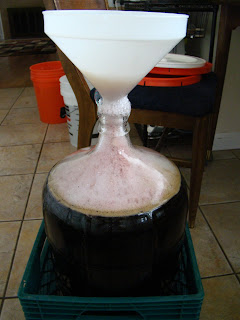 As it is for many homebrewers, my first-ever extract batch was an American pale ale kit, whcih made good sense in the Honolulu climate. For the second batch, though, I went for something more winter themed: a Murphy’s Irish Stout clone with 5 pounds of frozen blueberries added at flameout. Far from a typical dry stout, it ended up big and winey, and was definitely the most popular of my early batches. In late 2009, I put together an all-grain batch in the same mold; again, it went over well, especially with DeAunn. I thought I’d taken a hiatus from stouts and porters for now, but when Lisa, a new school friend of ours, found out about these past beers and volunteered to buy the blueberries for a new batch, I certainly wasn’t going to say no.
As it is for many homebrewers, my first-ever extract batch was an American pale ale kit, whcih made good sense in the Honolulu climate. For the second batch, though, I went for something more winter themed: a Murphy’s Irish Stout clone with 5 pounds of frozen blueberries added at flameout. Far from a typical dry stout, it ended up big and winey, and was definitely the most popular of my early batches. In late 2009, I put together an all-grain batch in the same mold; again, it went over well, especially with DeAunn. I thought I’d taken a hiatus from stouts and porters for now, but when Lisa, a new school friend of ours, found out about these past beers and volunteered to buy the blueberries for a new batch, I certainly wasn’t going to say no.The base beer was originally going to be a moderate-gravity milk stout with lactose and medium-dark crystal for residual sweetness, and a pound of roasted barley and 4 ounces each of American and British chocolate malts for roast complexity. I unwittingly measured out 8 ounces each of the chocolates into a bag together at the LHBS; with nothing else to do about it, I added a few more pounds of base malt to move this one into the foreign export range. I’d already bought a smack pack of London Ale III–my first time using this strain, and looking for its reported fruitiness to accentuate the blueberry addition to come–but with a much higher-gravity wort than originally expected and no time to do a starter, I added a couple tablespoons of Nottingham slurry.
After primary and a couple weeks sitting warm, Lisa brought over 10 pounds of frozen blueberries. There was some stress with the spigot on the secondary fermenter I planned to use not sealing properly, so I cleaned out and sanitized my 6-gallon carboy I’d used for primary, put it all back in there, and waited for the inevitable blowoff. I kept it cool so the blueberries’ fermentation wouldn’t get too rocking; even so, with the carboy so full there was a bit flooding the airlock after a few days. I punched down the swelling blueberries and replaced the airlock with aluminum foil; the blueberries were still fermenting away and pushing out a bit of fluid through the carboy opening by the time we left for the midwest for the holidays, but the fermentation seemed to be slow and steady instead of violent, which should be aided by the low thermostat setting while we’re gone.
I won’t be back to bottle this beast for almost a month. I fully expect the blueberries to ferment out completely and for the skins to impart a tannic, winey quality as had happened in the previous batches; with a high finishing gravity going into secondary, though, I hope there'll be plenty of residual sweetness to balance it. This should be an enjoyable way to ride out the early dark months of 2012.
Blueberry Stout Strikes Back - Base
Batch size: 5 gallons
Projected OG: 1.077
Projected SRM: 44.6
Projected IBU: 19.3
Boil time: 60 minutes
Brewhouse efficiency: 95%
Grains/Fermentables
70.6% - 9 lb 2-row
7.8% - 1 lb US roasted barley
6.0% - 12 oz C 80
3.9% - 8 oz US chocolate
3.9% - 8 oz UK chocolate
7.8% - 1 lb Lactose (0 min)
Hops
1 oz Northdown (7.2%) (60 min)
Yeast
1 pkg WY1318 London Ale III (no starter)
2 tbsp Nottingham (slurry)
Extras
10 lb Frozen blueberries (secondary)
Water additions (mash)
6 qts RO water
Brewday: 26 November 2011
Mash: 15 qts @ 154F for 60 minutes
Pre-boil volume: 6 gallons
Pre-boil SG (w/o lactose): 13.3P (1.054)
Fermented in swamp cooler at 63F ambient
2 December 2011: Krauesen has fallen; out of swamp cooler and into main area (65-70F ambient) to clean up
Secondary: 16 December 2011
SG: 1.025
OG (adjusted w/ estimated blueberry contribution): 1.085
Kept in 50F ambient room
Bottled: 5 February 2012
FG: 1.017
ABV: 8.9%
Bottled with 4 oz table sugar.
Tasting: A hit. Vinous character from the blueberries is most prominent aspect, dominating even over all that roasted grain. This one will keep coming back.



I'm drooling just reading about this...
ReplyDelete